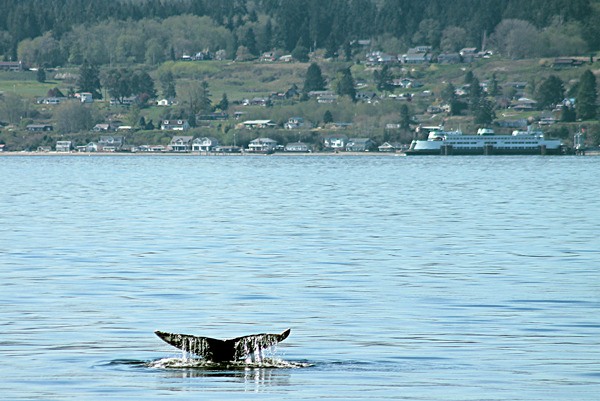Despite being packed with more than two dozen people, the deck of the Mystic Sea was dead silent. No one made a whisper.
Suddenly, tick, tick, tick — the silence was broken with snapping cameras and excited yells. Gray whales. They’d found them. The cycle of silence and snapping repeated again and again.
Whale season is in full swing, and the ruckus is a common occurrence on whale watching boats running out of Langley’s little marina, South Whidbey Harbor. The gray whales, or Saratoga grays as they are often called, have nearly iconic status on Whidbey and Camano Islands due to their annual visits to the Saratoga Passage and Possession Sound to feed on their favorite snack — ghost shrimp, also known as mud or glass shrimp. Every year the massive marine mammals return to wow spectators and provide South Whidbey whale experts such as Howard Garrett, co-director of Orca Network in Langley, with the opportunity to study the behemoths and their behavior.
“This is a unique, tiny micro-population of gray whales that have come every year since their first appearance in 1991,” Garrett said. “There are 10-12 Saratoga grays that frequent the area for food from March to the end of May.”
The gray whales can be seen hunting on the mud flats of Saratoga Passage and Possession Sound throughout the spring, their tails often emerging from the water; the acrobatic display isn’t for show but is done to help gray whales propel themselves down into the mud where their food lies.
The whales have a complex method of hunting their food — they blast nearly perfect round holes in the mud that contain the shrimp, worms and nutrients.
In other locations, gray whales dig long trenches, so the blasting method is a specialized technique employed by the Saratoga grays. Every once in a while, the curious creatures pop their heads out of water, exposing their barnacle-crusted faces and massive eyes.

“There is no other micro-population to my knowledge that specializes in hunting specific food in a specific area,” said Garrett. “Often, gray whales go to the wrong places for food and unfortunately starve, so it’s unique that these whales are so good at their job.”
The Saratoga grays each have their own distinct features and names given to them by South Whidbey whale experts. One whale, named Patch, is the most famous of the bunch, with a large white patch on his right side back towards his flukes, or tail lobes. Nonetheless, the feeding whales are a sight to behold. They bring tourists from across the globe.
“The whales are huge for the area’s tourism,” said Eric Rosemore, captain of the Mystic Sea Charters boat that offers Gray Whale watching tours from the South Whidbey Harbor.
“People from all over the world come to watch the whales; we’ve had people from places such as India, Russia and China in the past and today we had guests from across the country.”
Not only are the whales a money maker on South Whidbey, they are central to the history and culture of Puget Sound. Whales of all kinds are cultural icons to the Puget Sound Native American tribes, and have been used as a major source of food in days gone by.
Later this month is the annual Welcome the Whales Festival in Langley. The event, held this year on April 16-17, celebrates the arrival of gray whales to Whidbey Island.
This year’s festival features presentations from John Calambokidis of Cascadia Research Collective, a leading whale research outfit based in Olympia. He will present his current research on resident whales traveling through Saratoga Passage and Possession Sound, and will include video footage from cameras placed on the backs of whales to study their behavior.
Cascadia Research will also prepare a display for the Langley Whale Center in time for the Festival. Learn more at http://visitlangley.com/lp/whale-parade/.
The parade is 1:30 p.m. Saturday, April 16 with staging in the US Bank parking lot at Second Street and Anthes Avenue.
Grays in Oak Harbor? You bet
It’s not uncommon this time of year to spot gray whales just outside Oak Harbor.
About half the time after a whale watching boat from Oak Harbor departs the Oak Harbor Marina, it will slow down to view gray whales around Scenic Heights, Maylor’s Point and even Crescent Harbor, said Terica Ginther, who along with her husband Brett, own Deception Pass Tours.
Eventually, the Ginthers’ Island Whaler jet-drive catamaran will zip to Saratoga Passage and farther south to Possession Sound, the gray whales’ most popular feeding waters.
“About 50 percent of the time, they’re just right outside Oak Harbor,” Terica Ginther said.
“Probably 10 trips out of the whole season, they’re seen right at Scenic Heights. If you’re in Oak Harbor and you see our boat sticking around sometimes, we’re with whales.”
Deception Pass Tours, which is based in Oak Harbor, offers gray whale watching tours on Fridays, Saturdays and Sundays during the months of March and April out of Oak Harbor Marina.
The business also offers tours through Deception Pass and under the bridge out of Cornet Bay.
A summer whale watching tour begins in early June from Cornet Bay with the focus on all whales, including orcas, humpbacks and minkes.
Tour rates and more information may be found at www.deceptionpasstours.com


